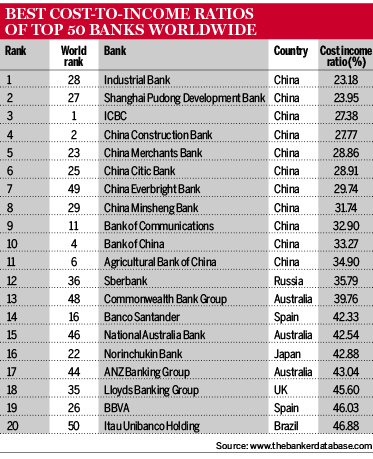Running a lean business is crucial for all banks – whether experiencing macro-economic or regulatory pressures, or operating in developed or emerging markets – and our analysis of cost-to-income ratios shows developing market banks are proving the more efficient. Out of the top 20 banks in our ranking, 13 are from emerging economies, almost all occupy the top part of the list and almost all are Chinese.
The ranking is based on financial data of the largest 50 companies in our global Top 1000 ranking, so this should not be entirely surprising given the overwhelming size of China’s lenders. More surprising, perhaps, is the absence of leading North American lenders.
China’s Industrial Bank leads the efficiency table with a mere 23.18% cost-to-income ratio. This is an improvement of more than 5.24 percentage points from a year earlier, and achieved despite a $1.18bn slide in operating income to $22.6bn, which was counterbalanced with a heavier cut in operating costs.
Industrial Bank’s performance mirrors that of its national peers in the ranking. All Chinese names show improved cost-to-income ratios despite most having closed the 2016 financial year with lower operating income amid a cooling economy. Next year’s analysis might produce a yet more flattering picture thanks to an improved macroeconomic forecast for 2017. Chinese banks, however, are still contending with high levels of non-performing loans and tighter regulation on some products.
Following the China pack is Russia’s Sberbank, in 12th with a 35.79% ratio, while, in 20th position, Brazil’s Itaú Unibanco is the final emerging market name in the list. Its much-improved income contributed to a substantial reduction of its cost-to-income ratio, down 7.57 percentage points to 46.88%.
In Brazil, lenders breathed a sigh of relief as the recession that had suffocated the country for the past two years began to loosen its grip, with banks such as Banco Santander feeling the benefit. The Madrid-based lender, in 14th place, saw a deterioration of its overall efficiency ratio, now 42.33%, as some of its overseas markets suffered several setbacks. Ratios of its Chilean, Peruvian and Polish banks, for example, worsened in 2016. After a tough 2015, its Brazilian operations halted the efficiency slide, contributing one-quarter of the group’s profits and displaying a much-improved cost-to-income ratio in the local market.
Meanwhile, Santander’s long-time rival and Latin American specialist, BBVA, is in 19th place with a 46.03% ratio.
Three Australian lenders appear in the table, the most efficient of which is Commonwealth Bank Group, in 13th place with 39.76%. Peers National Australian Bank and ANZ Banking Group display similarly good figures and place 15th and 17th, respectively.
In 16th position is Nurinchukin Bank, the national entity of Japan’s agricultural, fishery and forestry co-operatives. Despite levelling at a good 42.88%, its cost-to-income ratio has nearly doubled over the past two financial years, with costs outpacing declining operating income.
Lloyds Banking Group is the only UK lender in the list, in 18th place with an improved 45.6% ratio. This has been steeply declining since its 53.88% peak in 2014 – thanks mostly to major cost cutting and despite the erosion of total operating income over the last financial year. Lloyds’ operating costs went from $13.77bn in 2014 to $9.72bn in 2016 while, after rising to $26bn in 2015, total operating income shrank to $21.32bn in 2016.






